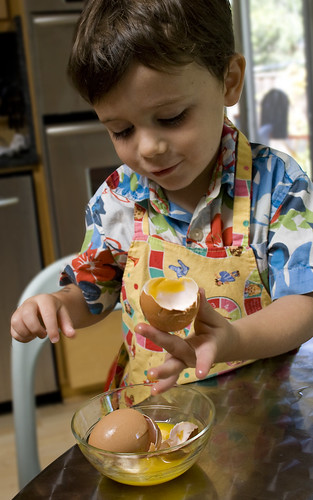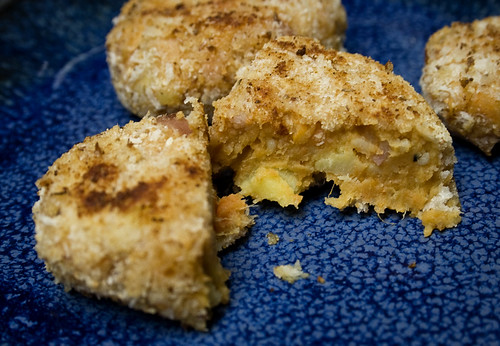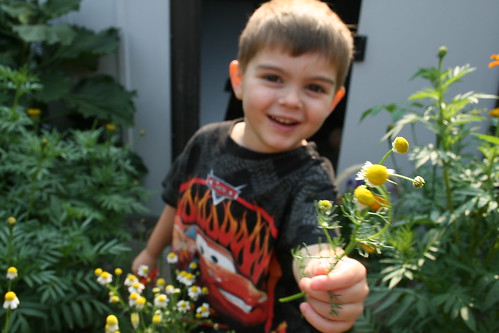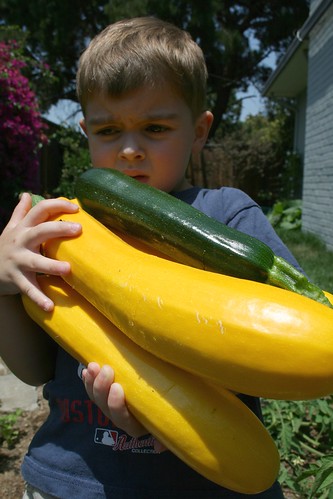 |
| Cracking eggs is a tough skill to master, but so much fun |
Another fun way to eat them is in the form of croquettes. A fancy term like that makes my kids suspicious, so we call them potato nuggets. My boys wouldn't touch mashed potatoes -- but a crispy breaded coating makes all the difference. You can mix in almost anything your kids might like (a great way to use up leftovers) then bake or pan-fry them. They freeze well, too, making them a great homemade "fast food" for busy days.
Kids who don't mind getting their hands dirty will have fun making these. My 3-year-old picked chicken-and-apple sausage as his mix-in, and handled everything from cracking eggs to squishing nuggets into shape and coating them with bread crumbs.
Sweet Potato Nuggets
This is a very basic recipe you can adapt to suit your taste. Choose deep orange sweet potatoes for maximum nutrition -- and fun.
2 pounds sweet potatoes, cooked and peeled (see note below)
1 teaspoon butter
salt and pepper to taste
optional add-ins: curry powder, chili powder, chopped meat, chopped chives or green onions, parmesan cheese
2 egg whites
1 1/2 cups bread crumbs (I mix regular bread crumbs with panko)
1 teaspoon butter
salt and pepper to taste
optional add-ins: curry powder, chili powder, chopped meat, chopped chives or green onions, parmesan cheese
2 egg whites
1 1/2 cups bread crumbs (I mix regular bread crumbs with panko)
Combine sweet potatoes, butter, salt and pepper, and any spices in a large bowl and mash with a fork or masher. Stir in any extras, such as chopped meat or herbs. Refrigerate until well chilled.
Put egg whites in a shallow bowl and stir briefly with a fork or small whisk. Put bread crumbs in another shallow bowl.
To form nuggets, scoop up a tablespoon or so of the potato mixture and shape into a nugget or ball. Dip into egg white and then into bread crumbs.
To freeze: Arrange nuggets on a plate or pan and set in the freezer for a few hours. Store frozen nuggets in a sealed freezer bag; take them straight out of the bag to bake.
To bake in the oven (my preferred method): Preheat oven to 400 degrees. Set nuggets on a parchment-lined baking sheet and spray lightly with olive oil or cooking spray. Bake for 20 minutes or until nuggets are lightly browned and crispy.
To pan-fry: Lightly spray a non-stick pan with olive oil or cooking spray. Cook nuggets over medium heat for a few minutes on each side until lightly browned and crispy. (You can also fry them in oil.)
Note: To cook sweet potatoes, wash them well and prick them with a fork. Rub with oil and bake in a 400 degree oven for 30 to 60 minutes or until soft. Or set on a white paper towel in the microwave and cook on high 12 to 18 minutes for four potatoes. Or cut peeled potatoes in 1 1/2-inch chunks and cook in a pressure cooker for 5 minutes.
Put egg whites in a shallow bowl and stir briefly with a fork or small whisk. Put bread crumbs in another shallow bowl.
To form nuggets, scoop up a tablespoon or so of the potato mixture and shape into a nugget or ball. Dip into egg white and then into bread crumbs.
To freeze: Arrange nuggets on a plate or pan and set in the freezer for a few hours. Store frozen nuggets in a sealed freezer bag; take them straight out of the bag to bake.
To bake in the oven (my preferred method): Preheat oven to 400 degrees. Set nuggets on a parchment-lined baking sheet and spray lightly with olive oil or cooking spray. Bake for 20 minutes or until nuggets are lightly browned and crispy.
To pan-fry: Lightly spray a non-stick pan with olive oil or cooking spray. Cook nuggets over medium heat for a few minutes on each side until lightly browned and crispy. (You can also fry them in oil.)
Note: To cook sweet potatoes, wash them well and prick them with a fork. Rub with oil and bake in a 400 degree oven for 30 to 60 minutes or until soft. Or set on a white paper towel in the microwave and cook on high 12 to 18 minutes for four potatoes. Or cut peeled potatoes in 1 1/2-inch chunks and cook in a pressure cooker for 5 minutes.




